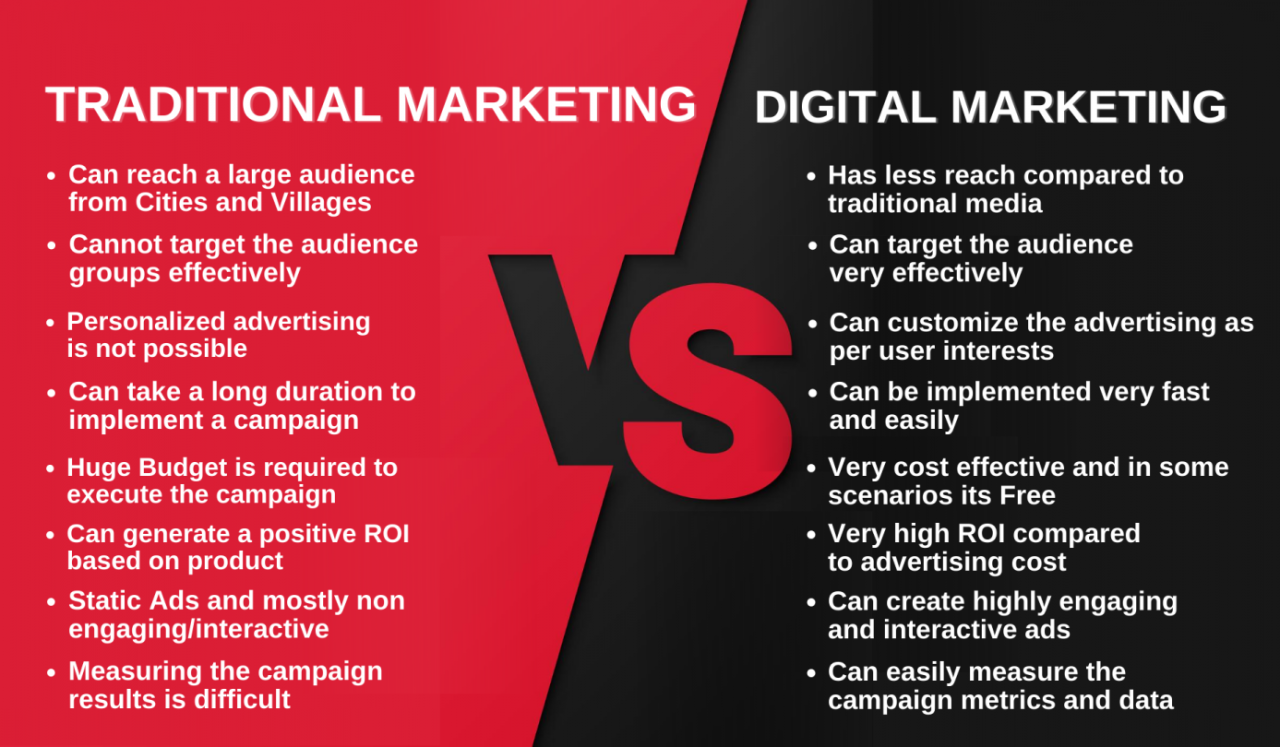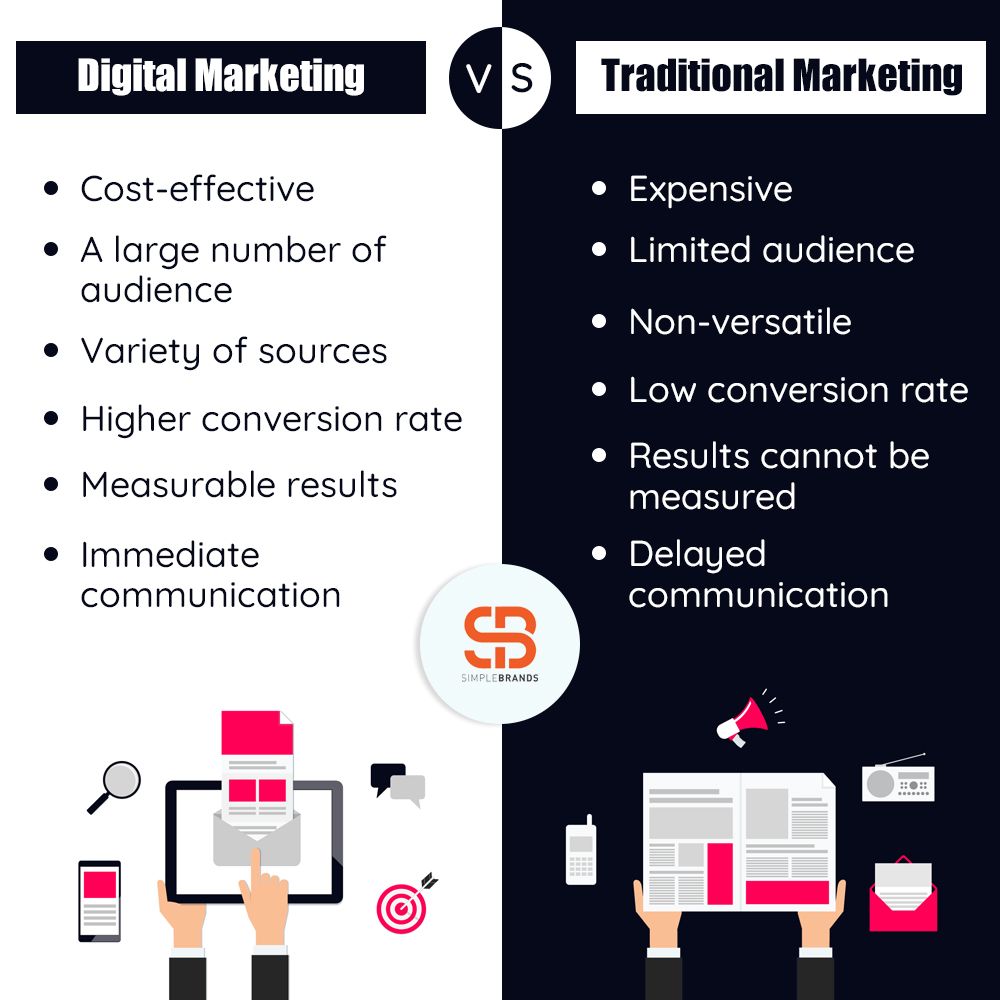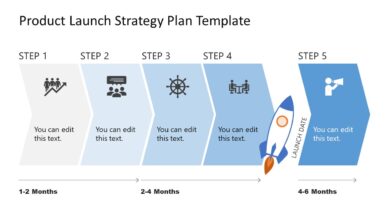
How to Spot the Differences Between Growth Marketing and Traditional Marketing
How to spot the differences between growth marketing and traditional marketing? It’s a question many marketers are asking, especially as the digital landscape evolves at breakneck speed. While traditional marketing has long relied on tried-and-true methods like print advertising and television commercials, growth marketing takes a more data-driven and agile approach, leveraging digital channels and testing strategies to optimize for rapid growth.
Understanding the key differences between these two approaches can be instrumental in choosing the right strategy for your business.
This blog post delves into the core principles, target audiences, marketing channels, measurement methods, and ROI potential of both traditional and growth marketing, providing a clear understanding of their unique strengths and weaknesses. We’ll explore real-world examples to illustrate how each approach can be applied effectively, and ultimately, help you decide which one is right for your brand.
Defining the Core Concepts

Understanding the core principles of traditional marketing and growth marketing is crucial for recognizing their key differences. These two approaches, while aiming to achieve similar goals, employ distinct strategies and focus areas.
Traditional Marketing
Traditional marketing refers to marketing strategies that were prevalent before the advent of the internet and digital technologies. It relies heavily on offline channels and methods to reach target audiences.
- Mass Marketing:Traditional marketing often employs a broad-brush approach, targeting a large audience with generic messages. This approach aims to reach as many people as possible, regardless of their specific needs or preferences.
- One-Way Communication:Traditional marketing typically involves a one-way communication flow, where businesses deliver messages to consumers without much opportunity for interaction or feedback. This is evident in methods like print advertising, television commercials, and radio broadcasts.
- Focus on Brand Building:Traditional marketing emphasizes building a strong brand image and creating brand awareness through consistent messaging and branding efforts. This approach aims to establish a positive perception of the brand in the minds of consumers.
- Measurement Challenges:Traditional marketing methods often face challenges in accurately measuring the effectiveness of campaigns. It can be difficult to track the impact of specific campaigns and attribute sales or conversions to particular marketing efforts.
Growth Marketing
Growth marketing is a data-driven approach that prioritizes continuous experimentation and optimization to drive sustainable business growth. It leverages a combination of traditional and digital marketing tactics, but with a strong emphasis on data analysis and customer-centric strategies.
- Data-Driven Decision Making:Growth marketing relies heavily on data analysis to understand customer behavior, identify growth opportunities, and optimize marketing campaigns. This data-driven approach allows for more precise targeting and personalized messaging.
- Customer Journey Focus:Growth marketing prioritizes understanding the entire customer journey, from initial awareness to post-purchase engagement. It aims to optimize each touchpoint and create a seamless and positive customer experience.
- Experimentation and Optimization:Growth marketing embraces a culture of experimentation, constantly testing new ideas and strategies to identify what works best for driving growth. This iterative approach allows for continuous improvement and adaptation to changing market conditions.
- Growth Hacking:Growth marketing often incorporates growth hacking techniques, which involve using creative and unconventional methods to achieve rapid growth. This might include leveraging social media trends, optimizing landing pages, or implementing referral programs.
Focus Comparison
| Characteristic | Traditional Marketing | Growth Marketing |
|---|---|---|
| Target Audience | Mass Audience | Specific Segments/Individuals |
| Communication Style | One-Way | Two-Way (Interactive) |
| Measurement | Difficult to Measure | Data-Driven and Measurable |
| Focus | Brand Building | Growth and ROI |
Target Audience and Reach
The target audience and reach of marketing campaigns are crucial factors that differentiate growth marketing from traditional marketing. Growth marketing prioritizes reaching specific user segments with highly tailored messages, while traditional marketing often takes a broader approach.
Target Audience for Traditional Marketing
Traditional marketing typically targets a broader audience, aiming to reach as many people as possible with its message. This approach often relies on mass media channels like television, radio, print advertising, and billboards, which have a wide reach but lack the precision of targeting specific user groups.
- Mass Media Channels:Traditional marketing campaigns often rely on mass media channels like television, radio, print advertising, and billboards to reach a broad audience. This approach aims to create brand awareness and generate leads by exposing the message to a large number of people.
- Geographic Targeting:Traditional marketing campaigns sometimes use geographic targeting to reach specific regions or demographics. For example, a local grocery store might advertise in a regional newspaper or on local radio stations to target consumers in its immediate area.
- Demographic Targeting:Traditional marketing campaigns may also target specific demographics based on factors like age, gender, income, and lifestyle. For instance, a luxury car manufacturer might advertise in magazines that cater to high-income earners or target specific television shows with affluent viewers.
Target Audience for Growth Marketing
Growth marketing focuses on identifying and targeting specific user segments based on their behavior, interests, and needs. This approach utilizes data-driven insights to personalize marketing messages and tailor them to the unique characteristics of each target group.
- Behavioral Targeting:Growth marketing often employs behavioral targeting, which analyzes user actions and interactions to identify specific interests and preferences. For example, a website might use cookies to track user browsing history and display targeted ads based on their past behavior.
- Interest-Based Targeting:Growth marketing can also target users based on their expressed interests, such as hobbies, passions, or specific topics they follow. This approach allows marketers to deliver highly relevant messages to users who are more likely to engage with them.
- Needs-Based Targeting:Growth marketing often focuses on addressing specific user needs and pain points. For instance, a software company might target users who are struggling with a particular problem and offer a solution tailored to their specific requirements.
Reach of Traditional Marketing and Growth Marketing
The reach of traditional marketing is typically broader, encompassing a larger audience through mass media channels. However, growth marketing often achieves a higher conversion rate due to its targeted approach, as it focuses on reaching users who are more likely to be interested in the product or service.
- Traditional Marketing:Traditional marketing campaigns often have a broader reach, encompassing a larger audience through mass media channels like television, radio, print advertising, and billboards. This approach aims to create brand awareness and generate leads by exposing the message to a large number of people.
- Growth Marketing:Growth marketing campaigns typically have a narrower reach but achieve a higher conversion rate by focusing on specific user segments. This approach leverages data-driven insights to identify and target users who are more likely to be interested in the product or service, leading to a more effective and efficient marketing strategy.
Marketing Channels and Tactics
Understanding the channels and tactics used in both traditional and growth marketing is crucial for discerning their differences. While traditional marketing relies on established, mass-reach channels, growth marketing emphasizes data-driven, agile approaches to reach specific audiences.
Figuring out the difference between growth marketing and traditional marketing can be tricky, especially when you’re trying to connect the dots between different strategies. For instance, if you’re looking at how a university like the University of Michigan chooses its new president, you might see some parallels to growth marketing.
In the case of the University of Michigan picking Santa Ono as its new president months after the ouster of Mark Schlissel, there’s a focus on finding the right fit for the future, much like growth marketing focuses on identifying and nurturing the right audience for long-term success.
Just like a growth marketer, the University of Michigan is looking for someone who can drive positive change and growth.
Traditional Marketing Channels
Traditional marketing channels have been the mainstay of marketing for decades, relying on mass media and broad reach to connect with potential customers.
- Television Advertising: This channel provides broad reach and high impact, particularly for mass-market products and services. However, its cost is high, and targeting specific audiences can be challenging.
- Print Advertising: Newspapers, magazines, and billboards offer a visual platform for brands, but their effectiveness has declined with the rise of digital media. They are still relevant for local businesses or niche audiences.
- Radio Advertising: Radio can be effective for local targeting and reaching specific demographics, but its reach is limited compared to other channels.
- Direct Mail: While considered less effective than digital marketing, direct mail can still be effective for targeted campaigns, especially for local businesses or specific demographics.
- Public Relations (PR): PR focuses on building positive relationships with the media and generating positive publicity for brands. It can be effective for brand building and influencing public perception.
Growth Marketing Channels
Growth marketing embraces a data-driven approach, focusing on digital channels and utilizing analytics to optimize campaigns for maximum impact.
- Search Engine Optimization (): Optimizing websites for search engines helps attract organic traffic and improve brand visibility. It is a long-term strategy that requires ongoing effort.
- Content Marketing: Creating valuable and engaging content, such as blog posts, articles, and videos, attracts audiences and builds brand authority. It can be effective for building trust and driving conversions.
- Social Media Marketing: Engaging with audiences on social media platforms helps build brand awareness, drive traffic, and foster community. It requires consistent engagement and content creation.
- Email Marketing: Sending targeted emails to subscribers is effective for nurturing leads, promoting products, and driving sales. It requires segmenting audiences and personalizing messages.
- Paid Advertising: Utilizing platforms like Google Ads and Facebook Ads allows for targeted campaigns and immediate results. It requires careful budgeting and optimization to maximize return on investment (ROI).
- Affiliate Marketing: Partnering with influencers or other businesses to promote products or services can expand reach and drive sales. It requires careful selection of partners and tracking performance.
Effectiveness of Traditional and Growth Marketing Channels
The effectiveness of traditional and growth marketing channels varies depending on the target audience, budget, and marketing objectives.
| Channel | Traditional Marketing | Growth Marketing |
|---|---|---|
| Reach | Broad, mass-market | Targeted, specific audiences |
| Cost | High, often fixed costs | Variable costs, often lower than traditional |
| Measurability | Difficult to track results | Highly measurable, with detailed analytics |
| Speed | Slow, often long lead times | Fast, with immediate results possible |
| Flexibility | Less flexible, difficult to adjust campaigns | Highly flexible, easily adaptable to changes |
Traditional marketing channels can still be effective for building brand awareness and reaching large audiences. However, growth marketing offers greater flexibility, measurability, and targeting capabilities, making it a more efficient and effective approach for modern businesses.
Measurement and Analysis
The way we measure success in marketing is a key difference between traditional and growth marketing. Traditional marketing often focuses on broad metrics, while growth marketing emphasizes data-driven insights and iterative improvement.
Figuring out the difference between growth marketing and traditional marketing can feel like navigating a maze, but there’s a simple trick: growth marketing focuses on data-driven strategies for rapid expansion, while traditional marketing relies on established methods like print ads.
Take, for example, the recent news of Trump embracing LIV Golf, backing a new Saudi strategy – it’s a prime example of how traditional marketing can be used to achieve a specific goal. Ultimately, understanding the core focus of each approach will help you choose the right strategy for your brand’s growth.
Traditional Marketing Measurement Methods
Traditional marketing relies on a set of established metrics to gauge campaign effectiveness. These metrics are often used to evaluate the overall reach and impact of marketing efforts.
- Brand Awareness: Measures how familiar the target audience is with a brand or product. This can be assessed through surveys, focus groups, and brand recall studies.
- Market Share: Represents the percentage of the total market that a company or brand controls. This metric is calculated by dividing a company’s sales by the total sales in the market.
- Return on Investment (ROI): Measures the profitability of a marketing campaign by comparing the cost of the campaign to the revenue generated. This metric helps determine the effectiveness of marketing spend and identify areas for improvement.
Growth Marketing Measurement Methods
Growth marketing emphasizes a data-driven approach to understanding customer behavior and optimizing marketing campaigns. This approach involves using a variety of tools and techniques to track performance and identify areas for improvement.
- Website Analytics: Tools like Google Analytics provide detailed insights into website traffic, user behavior, and conversion rates. This data can be used to identify areas for improvement on the website and optimize the user experience.
- A/B Testing: This method involves creating two versions of a marketing asset (e.g., website landing page, email subject line) and comparing their performance. This allows marketers to identify the most effective elements of their campaigns and continuously improve their strategies.
- Customer Lifetime Value (CLTV): This metric measures the total revenue a customer is expected to generate over their relationship with a company. CLTV is a valuable indicator of customer loyalty and can help marketers prioritize efforts to retain existing customers.
Key Performance Indicators (KPIs)
The choice of KPIs is crucial for understanding the effectiveness of marketing efforts. Traditional and growth marketing often prioritize different KPIs based on their specific goals and objectives.
| Metric | Traditional Marketing | Growth Marketing |
|---|---|---|
| Brand Awareness | Brand Recall, Brand Recognition | Website Traffic, Social Media Engagement |
| Lead Generation | Number of Leads, Lead Cost | Conversion Rate, Lead Quality |
| Sales | Revenue, Sales Growth | Customer Acquisition Cost (CAC), Customer Lifetime Value (CLTV) |
Examples of Traditional and Growth Marketing Strategies

Now that we’ve defined the core concepts, target audience, marketing channels, and measurement metrics, let’s delve into real-world examples of traditional and growth marketing strategies. This will help us visualize how these approaches manifest in practice and understand their respective strengths and weaknesses.
Traditional Marketing Examples
Traditional marketing strategies are often associated with mass media and outbound approaches. They aim to reach a large audience with a consistent message. Here are some examples:
- Print Advertising:Placing ads in newspapers, magazines, and brochures is a classic example of traditional marketing. These ads can be targeted to specific demographics based on the publication’s readership. For example, a car manufacturer might place an ad in a magazine focused on luxury cars to reach a high-income audience.
- Television Commercials:TV commercials remain a powerful tool for reaching a wide audience, particularly during primetime viewing hours. They can showcase products and services in a dynamic and engaging way. A popular example is the Super Bowl, where brands pay millions of dollars for 30-second spots to reach millions of viewers.
- Direct Mail:Sending physical mailers, such as flyers, postcards, and brochures, directly to potential customers is another traditional approach. This method allows for personalized messaging and targeted audience segmentation. For example, a local bakery might send out a direct mail campaign offering a discount to residents in a specific neighborhood.
Growth Marketing Examples
Growth marketing focuses on data-driven strategies that aim to drive sustainable growth. These strategies are often digital and involve a more interactive and personalized approach. Let’s explore some examples:
- Content Marketing:Creating valuable and engaging content, such as blog posts, articles, videos, and infographics, is a cornerstone of growth marketing. This content attracts a target audience and establishes thought leadership. For instance, a software company might create a blog post on “Top 5 Productivity Hacks for Remote Teams” to attract potential customers interested in improving their workflow.
- Social Media Marketing:Utilizing platforms like Facebook, Instagram, Twitter, and LinkedIn to connect with customers, build communities, and promote products or services is a powerful growth marketing tactic. This involves engaging with followers, running targeted ads, and using social listening to understand customer sentiment.
For example, a fashion brand might run a social media contest to generate buzz and increase brand awareness.
- Email Marketing:Sending personalized emails to nurture leads, promote offers, and build relationships is a key growth marketing strategy. Effective email campaigns use segmentation, automation, and A/B testing to optimize engagement and conversion rates.
Understanding the differences between growth marketing and traditional marketing is crucial for any business. Growth marketing focuses on rapid scaling and data-driven strategies, while traditional marketing often relies on broader reach and brand awareness. To determine where you stand financially, take this quiz and get personalized advice: where do you stand financially get a score on this quiz and our advice.
By aligning your marketing approach with your financial goals, you can effectively leverage the strengths of both growth and traditional marketing to achieve sustainable success.
For example, an online retailer might send an email to customers who abandoned their shopping carts, reminding them of the items they left behind.
Comparing Effectiveness, How to spot the differences between growth marketing and traditional marketing
The effectiveness of traditional and growth marketing strategies depends on various factors, including the industry, target audience, and campaign objectives.
- Traditional Marketing:
- Strengths:Traditional marketing can reach a large audience, create brand awareness, and build trust through established media channels.
- Weaknesses:Traditional marketing can be expensive, difficult to track ROI, and lack the personalized touch of growth marketing.
- Growth Marketing:
- Strengths:Growth marketing is data-driven, cost-effective, and allows for precise targeting and personalization. It is also easier to track results and optimize campaigns for better performance.
- Weaknesses:Growth marketing can be time-consuming to implement, require specialized skills, and rely heavily on technology and data analytics.
It’s important to note that traditional and growth marketing strategies are not mutually exclusive. In fact, many businesses use a blended approach, leveraging the strengths of both to achieve their marketing goals.
When to Use Traditional and Growth Marketing

Choosing the right marketing approach is crucial for achieving your business goals. While both traditional and growth marketing have their strengths, understanding their specific applications is essential. This section delves into scenarios where each approach proves most effective.
Traditional Marketing’s Effectiveness
Traditional marketing, with its established methods, remains relevant in specific situations. Its effectiveness lies in its ability to reach broad audiences and build brand awareness. Here are some scenarios where traditional marketing excels:
- Building Brand Awareness and Trust:Traditional channels like television, radio, and print advertising are powerful for establishing brand recognition and fostering trust among a large audience. This is particularly beneficial for new businesses or those aiming to establish a strong brand identity.
- Reaching Specific Demographic Groups:Traditional media often allows for targeted advertising based on demographics, making it suitable for reaching specific audiences. For instance, print publications cater to niche interests, while television commercials can be aired during specific programs appealing to specific demographics.
- Generating Leads and Sales:Traditional marketing, especially direct mail and print advertising, can effectively generate leads and drive sales, especially for businesses selling tangible products or services with a clear value proposition.
- Local Business Promotion:Traditional channels like local newspapers, community events, and billboards are effective for promoting local businesses, attracting customers within a specific geographical area.
Growth Marketing’s Effectiveness
Growth marketing focuses on data-driven strategies to achieve sustainable business growth. Its agility and adaptability make it ideal for:
- Optimizing Existing Marketing Channels:Growth marketing leverages data analytics to identify areas for improvement within existing marketing channels, maximizing their effectiveness. For example, A/B testing different website layouts or email subject lines can significantly enhance conversion rates.
- Experimenting with New Channels and Tactics:Growth marketing embraces experimentation and embraces emerging channels and tactics. This allows businesses to adapt to evolving consumer behaviors and discover new growth opportunities. For example, experimenting with influencer marketing or social media campaigns can unlock new customer segments.
- Driving User Acquisition and Retention:Growth marketing prioritizes user acquisition and retention strategies, employing techniques like content marketing, search engine optimization (), and social media engagement to attract and retain customers. This approach focuses on building a loyal customer base through valuable content and engaging experiences.
- Scaling Business Growth:Growth marketing’s data-driven approach allows businesses to scale their marketing efforts effectively. By identifying successful campaigns and strategies, they can replicate and optimize them for broader reach and impact.
Examples of Companies Utilizing Both Approaches
Many successful companies effectively integrate both traditional and growth marketing strategies to achieve their objectives. Here are some examples:
- Nike:Nike utilizes traditional marketing through television commercials and print ads to build brand awareness and promote new product launches. They also employ growth marketing strategies, including social media engagement, influencer marketing, and targeted digital advertising to reach specific audiences and drive sales.
- Coca-Cola:Coca-Cola, a renowned brand, leverages traditional channels like television and print advertising for brand recognition and emotional connections. They also utilize growth marketing tactics, including social media campaigns, experiential marketing, and digital content creation to engage with consumers and drive brand loyalty.
- Amazon:Amazon, a leader in e-commerce, utilizes traditional marketing through print advertising and television commercials to promote its Prime membership and key products. They also employ growth marketing strategies, including targeted email campaigns, personalized recommendations, and A/B testing to optimize customer experience and drive conversions.
Epilogue: How To Spot The Differences Between Growth Marketing And Traditional Marketing
In conclusion, understanding the differences between traditional and growth marketing is essential for navigating the ever-changing marketing landscape. While traditional marketing remains valuable for building brand awareness and reaching a broad audience, growth marketing excels at driving measurable results and achieving rapid growth.
Ultimately, the most effective approach depends on your specific business goals, target audience, and budget. By carefully considering the strengths and weaknesses of each approach, you can develop a comprehensive marketing strategy that drives sustainable success.






